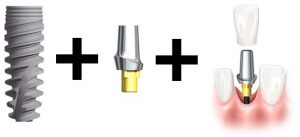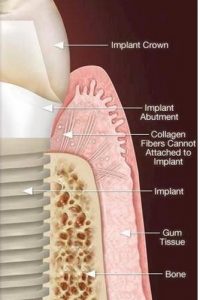 Dental implants look and function like natural teeth. That’s what makes them so effective and desirable as the most optimal replacement option for missing teeth. But when it comes to caring for them, they are somewhat different than natural teeth. So how is caring for implants any different?
Dental implants look and function like natural teeth. That’s what makes them so effective and desirable as the most optimal replacement option for missing teeth. But when it comes to caring for them, they are somewhat different than natural teeth. So how is caring for implants any different?
Before we answer that, a definition may be in order. We often think of dental implants as replacement teeth. But strictly speaking a dental implant is a metal screw usually and mostly composed of titanium. Implants are surgically screwed into your jaw bone, hence why the underlying bone is so critical to the future success of the implant. Then on top off this screw there is a secondary attachment called an abutment, that gets screwed into the implant before the final crown can be placed on the implant. So basically, any implant will have three parts to it: the implant + abutment + the crown.
Just like a natural tooth, a dental implant relies on healthy tissue for support. This tissue is usually called gingiva and its the pink gums that sit around natural teeth and the crowns that sit on implants. Just like a natural tooth, plaque can build up around an implant as well. And just like natural teeth, the plaque needs to be removed from around the implants. This is why it is important that you clean the implants just like you natural teeth by brushing and flossing anytime after you eat.
Unlike natural teeth, dental implants are not susceptible to cavities, but the built-up of plaque around the crown on an implant can lead to a gum infection. As shown in the diagram below, the collagen fibers that typically insert into a natural tooth, do not do the same in implants, which makes them more susceptible to gum recession. These fibers can only create a turtle neck of tissue around the implant and are not as tough on preventing the ingress bacteria around the implant. Once the implant surface becomes contaminated with bacteria it is very difficult to remove them. This become a “progressive” disease and will only worsen with time if left untreated.
This is usually referred to “peri-implantitis” which literally mean inflammation around the implant. It can lead to extensive bone loss around the implant and the eventual need to remove the implant itself.
Hence, in addition to daily home care, it is important to see your dentist for regular checkups, especially if you are already diagnosed with gum disease, i.e. periodontitis; because the same bacteria that cause gums disease can also cause peri-implantitis around implants. This is the reason why many professionals recommend not placing implants in any patients that have gum disease. Let your dentist know there’s an implant.
To find out more about dental implants, and whether they are right for you, contact us for a consultation. We have offices in San Francisco and Cupertino. Give us a call at 415-813-6400 in San Francisco or 408-253-6084 in Cupertino.


